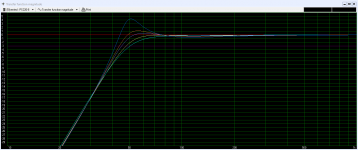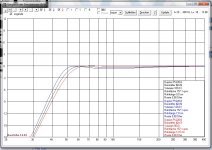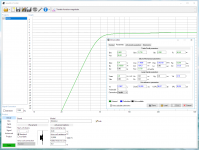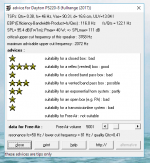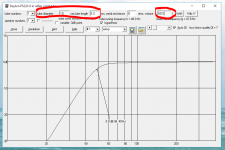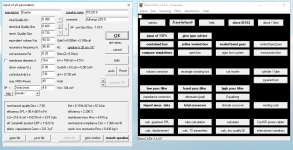Dr Scott, would you mind looking at your e-mails? Of the several projects I’m on a tight timeframe to complete, those new Castles are at the top of my personal bucket list.
The XO design needs to await rough assembly of enclosures for acoustic measurements of drivers in situ to proceed. Or, I could just use an on-line calculator 😱
Emails are all over the shop at the moment (our friends from Microsoft as usual) -remind me what needs sorting re the box & we'll address the filter when we get to that stage.
ICG, your graph is exactly what I was looking for! Great comparison! What programm is that? Is it only in German? How much does this program cost? I would love to play with it and learn more myself playing around with such graphs will allow me to choose for the "best" compromise according to my personal needs and future drivers. If you could personal message me with the saved file I would be very happy.
I'm not ICG, but most decent free loudspeaker alignment software will allow you to do the same. WinISD is one of the most popular.
The 80L vented green line looks very nice indeed, I agree with you.
I'm curious how the graph lines would look for a 100 Liters, and 120 Liters vented box.
That nice maximally flat green line will result in 99.9% of real-life conditions in severely underdamped bass (i.e. big peaking, 'boom', 'one-note', all those buzzwords the audiophiles like to throw around) due to boundary / room gain. It's a mathematical derivation only, and assumes anechoic conditions. However, what is flat in an anechoic chamber is not under normal conditions.
Sothat I can comapre the vented 80L, 100L, 120L to see how those volumes would theoretically influence the frequency response for this particular modern full range driver.
Assuming the same tuning frequency and drive unit, the larger the box volume, the more peaking you will have at box tuning (a very bad thing in most cases), with attendent losses in the two octaves (roughly) above that. For example, the attached. This is the PS220-8 in various box volumes, tuned to the same frequency in each.
Turquoise = 70 litres
Yellow = 80 litres
Lilac = 100 litres
Orange = 120 litres
Dark blue = 250 litres for illustration.
Which of these alignments is likely to be the most practical under many (not all) 'real world' conditions? In the majority of cases, it's the 70 litre box. Even this isn't really ideal; it would be better in many situations tuned lower, but as-is, it's a start.
Note that most box simulation software covering sealed, reflex boxes etc. will show minor differences from each other due to slightly different damping assumptions etc.; the differences are not generally enough to cause major issues. Note also that behaviour will change for each volume if you tune it to a different frequency; that's something for you to try yourself as it's not practical for the rest of us to do so.
Attachments
Last edited:
Here's one of the most popular free program used around DIYaudio. It's WinISD.
You can download here:
WinISD - Linearteam
And a nice tutorial here:
WinISD Pro Tutorial and Download (A detailed guide on how to use WinISD Pro) - Home Theater Forum and Systems - HomeTheaterShack.com
You will see that going bigger is not best, as response will have bumps, and you will also limit the power you can use to listen to your system, as you will hit Xmax a lot sooner.
You can download here:
WinISD - Linearteam
And a nice tutorial here:
WinISD Pro Tutorial and Download (A detailed guide on how to use WinISD Pro) - Home Theater Forum and Systems - HomeTheaterShack.com
You will see that going bigger is not best, as response will have bumps, and you will also limit the power you can use to listen to your system, as you will hit Xmax a lot sooner.
ICG, your graph is exactly what I was looking for! Great comparison! What programm is that? Is it only in German? How much does this program cost? I would love to play with it and learn more myself playing around with such graphs will allow me to choose for the "best" compromise according to my personal needs and future drivers. If you could personal message me with the saved file I would be very happy.
The program is the BassCADe. Default is German but you can switch it to English and there are other languages available I think, at least the program has a switch to others. It's very easy to use, so have fun experimenting with it, you can learn what things are tied together and where you got freedom to tweak things to your taste.
Your graph is convinving as it compares both "optimal" volumes of the sealed and vented in one gragh, for the frequency responses of this promising driver.
That's why I posted it. 😉 I hoped it would show you enough to make yor mind up and I'm glad it did. 🙂
The 80L vented green line looks very nice indeed, I agree with you.
I'm curious how the graph lines would look for a 100 Liters, and 120 Liters vented box.
Sothat I can comapre the vented 80L, 100L, 120L to see how those volumes would theoretically influence the frequency response for this particular modern full range driver.
Well, you can not only change the volume, you can also change the port surface and length, which gives you complete freedom about the tuning. For identical tuning but different port sizes you just have to match the tuning frequency.
Here are the comparisons in bigger volumes:
I would use the 80l one. I noticed now the ports are unnecessarily big, you can ofcourse chose smaller ones, the length is shorter then.
Thanks everybody, and thanks ICG for your awesome visualisations! Much much appreciated! Sometimes a single graph says more than a thousand words...
NP, I like to help and to see it did made my day. 😀
Finally just to be sure:
Does "Röhrflache (qcm)" mean the opening size in squared centimeters?
Does "Röhrlange (cm)" mean the length of the opening in centimeters?
Yes and yes.
Attachments
I just want to point out that a big part of the problem with bass reflex is that at the calculated FB you will often get A LOT of phase wrap, and often also higher up in the spectrum. This causes integration issues, and takes away much of the detail level. Please take into account at the very least data relating to phase, group delay, port air velocity. It is very important to consider at least these few things, in order to avoid disappointment after making sawdust.
I just want to point out that a big part of the problem with bass reflex is that at the calculated FB you will often get A LOT of phase wrap, and often also higher up in the spectrum. This causes integration issues, and takes away much of the detail level. Please take into account at the very least data relating to phase, group delay, port air velocity. It is very important to consider at least these few things, in order to avoid disappointment after making sawdust.
The phase and other 'stray' mid-crap can be reduced a lot by damping and by good port placement (hint: back side helps a lot). I don't see that as a big problem.
The group delay is ofcourse a thing but that ist really only problem on (very) low tuned speakers. Sure, deep bass is something I like too but maximum low is often not the best sounding option. Not so deep tuned speakers often sound cleaner, more impulsive and homogenous. Usually it is not important it goes as deep as possible, it's more important HOW it sounds in the bass.
Like I already said, if it's not too big, I'd use the 80l version. The bigger ones go deeper, that's true but it's not a completely 'clean' tuning anymore. Or the Dayton in a sealed cab and a subwoofer under it, maybe a sealed enclosure 15".
The lower you go the more you can "get away" with high group delay.
It doesn't matter that much on let's say at 30Hz sq-wise.
For example 35ms at 30Hz is acceptable whereas 35ms at 100Hz is horrible.
It doesn't matter that much on let's say at 30Hz sq-wise.
For example 35ms at 30Hz is acceptable whereas 35ms at 100Hz is horrible.
I did not expect that from you ICG, rear port?
Phase wrap is a real mess of an issue on bass reflex, and probably much of the reason why some people tend to cling to OB as some sort of holy grail. If you have not experienced the issue, I think you are just assuming it is not important.
It's not about getting as much deep bass as possible from a speaker, but getting clean sound over the entire bandwidth, as well as predictable behaviour on intended xo points. If you have phase issues at 80hz you need either to adapt the room to deal with it, or use 6 times thickness of damping material which I find slightly unrealistic. Move the phase issues up to 500hz and you need 1 times thickness of same dampening material.
Edit:
GP: I agree that group delay is less of an issue down low than up higher, but 35ms/30hz is still a bit much in my opinion. OK for PA where I would not expect too much and there are reflections all over, but not good enough in my house.
Phase wrap is a real mess of an issue on bass reflex, and probably much of the reason why some people tend to cling to OB as some sort of holy grail. If you have not experienced the issue, I think you are just assuming it is not important.
It's not about getting as much deep bass as possible from a speaker, but getting clean sound over the entire bandwidth, as well as predictable behaviour on intended xo points. If you have phase issues at 80hz you need either to adapt the room to deal with it, or use 6 times thickness of damping material which I find slightly unrealistic. Move the phase issues up to 500hz and you need 1 times thickness of same dampening material.
Edit:
GP: I agree that group delay is less of an issue down low than up higher, but 35ms/30hz is still a bit much in my opinion. OK for PA where I would not expect too much and there are reflections all over, but not good enough in my house.
Last edited:
I did not expect that from you ICG, rear port?
Phase wrap is a real mess of an issue on bass reflex, and probably much of the reason why some people tend to cling to OB as some sort of holy grail. If you have not experienced the issue, I think you are just assuming it is not important.
You've got a phase shift at the port frequency, you can't do anything against that because that's the principe of the Helmholtz resonator. But IF you got issues in the mid, then yes, a back port can help. Often it's not an issue though.
It's not about getting as much deep bass as possible from a speaker, but getting clean sound over the entire bandwidth, as well as predictable behaviour on intended xo points. If you have phase issues at 80hz you need either to adapt the room to deal with it, or use 6 times thickness of damping material which I find slightly unrealistic.
No, you can damping material can make a huge difference in the bass, an absorption sump or an internal absorption resonator are actually excellent ways to deal with standing waves within the speaker. Or what did you mean with phase problems IN the speaker? Anyway, the human ear isn't sensitive to phase changes below ~100Hz, so that's not an issue anyway unless you've got interferences (i.e. room modes) which lead to a bad frequency response. On the other hand, a bassreflex port over 100 Hz sounds quite ugly and should definitely be avoided.
Move the phase issues up to 500hz and you need 1 times thickness of same dampening material.
I'm sorry but I can't say it another way, if you've got a phase issue at 500Hz because of the reflex port, then you've done something wrong.
GP: I agree that group delay is less of an issue down low than up higher, but 35ms/30hz is still a bit much in my opinion. OK for PA where I would not expect too much and there are reflections all over, but not good enough in my house.
This was just an example.
But yes, it is a lot for high standards.
Guys I want to thank everybody to not only answer my original question in details, but your insights on closed / vented box design, and tips on the porgrams! The recent posts are a little too complicated for me but that says something about your experienced perfectionism and your attention to details to get things sound a tad bit more beautiful in order to get that elevated state of being listening to the music. Great!
I tried both programs and already have a personal favourite:
Below the first shot is from WinISD, where I put manually all the details because the brand Dayton Audio is not even enlisten let alone this relatively new driver !!!!
BassCADe on the other hand already got all the parameters already perfect from all Dayton Audio speakers and approximately 5.000 other speaker drivers more. Very fresh approach!
In conclusion, if I have understood and played well with parameters and listened to your expert advise, I'm going for:
> Vented enclosure 80 Liters inner volume.
> Vented port 10 cm in diameter, 5 cm long.
There are different opinions about placing the vented port in front or back. What would the difference of front or back port hole be?
Also, what if I place the porthole on the bottom of the speaker, and have the speaker stand on feet 5 cm above the ground?
For filling I would like to experint without any filling, with some stuffing, and with even more stuffing try to see what happens. So for this reason I will have the back wooden piece screwable sothat I can take it apart and test left speaker with and right speaker without filling for example as I advance and understand the differences in what stuffing does.
I can place the speakers anywhere I want in a space 6x6 square meters. both being far apart from eachother say 4 meters apart as well as 4 meters apart from the listening position. A nice triangle which is flexible and can be changed.
I tried both programs and already have a personal favourite:
Below the first shot is from WinISD, where I put manually all the details because the brand Dayton Audio is not even enlisten let alone this relatively new driver !!!!
BassCADe on the other hand already got all the parameters already perfect from all Dayton Audio speakers and approximately 5.000 other speaker drivers more. Very fresh approach!
In conclusion, if I have understood and played well with parameters and listened to your expert advise, I'm going for:
> Vented enclosure 80 Liters inner volume.
> Vented port 10 cm in diameter, 5 cm long.
There are different opinions about placing the vented port in front or back. What would the difference of front or back port hole be?
Also, what if I place the porthole on the bottom of the speaker, and have the speaker stand on feet 5 cm above the ground?
For filling I would like to experint without any filling, with some stuffing, and with even more stuffing try to see what happens. So for this reason I will have the back wooden piece screwable sothat I can take it apart and test left speaker with and right speaker without filling for example as I advance and understand the differences in what stuffing does.
I can place the speakers anywhere I want in a space 6x6 square meters. both being far apart from eachother say 4 meters apart as well as 4 meters apart from the listening position. A nice triangle which is flexible and can be changed.
Attachments
Last edited:
Do yourself a favour & tune the box lower, as suggested above. Maximally flat alignments rarely work well in practice & are partly responsible for vented boxes having a questionable reputation in some quarters.
Max flat (Q-0.707) butterworth alignment) needs ~37 litres F10 50 Hz (anechoic). I like bessel (Q=0.58) which requires 68 litre, F10 43 Hz. It starts rolling off sooner, So anywhere from 25-55 litre well damped should do. Room gain will usually get you a bit lower than this, but rooms dominante and its dimensions will typically cause a “roller-coaster” response very much dependent on room placement and listening position.
Note that less volume is needed when damping is considered.
14 litres has a Q of about 1 (underdamped) and a near 2 dB peak at ~150 Hz and F10 not much better than 60 Hz.
I have a 60 litre miniOnken for these that reaches near 40 Hz F10 and rools off later.
dave
Do you like these drivers?
//
I’ve yet to listen to a pair, but have a set i am treating for a client as we speak so i will get a chance (but like the AN 10 Classic Ferrite i just shipped off) it won’t be in any decent box. The one initial impression i get is that the phase plug is asethetically a mess. And i don’t like the 5-way connection posts, althou unlike the AN it also has tabs so the posts can be ignored.
dave
dave
Do yourself a favour & tune the box lower, as suggested above. Maximally flat alignments rarely work well in practice & are partly responsible for vented boxes having a questionable reputation in some quarters.
Eeeh you mean lower like less flat and more round shaped graph with a lower volume of say 70 liters?
Partly, but I didn't say reduce the enclosure volume. I said you would be well advised to tune your chosen box volume to a lower frequency rather than aiming for a maximally flat alignment.
As noted above, the box [alignment] design software assumes anechoic conditions. Which is fine as far as it goes, but when you put a speaker with a maximally flat anechoic response into a real room, with boundary gain etc., then in 99% of cases you will end up with excessive bass gain. Using a flat anechoic alignment is actually one of the reasons vented boxes have a questionable reputation in some circles, because with certain exceptions they don't tend to work too well in practice. They can be / are a useful starting point however.
A slightly lower tuning & better damped alignment tends to be more effective & provide more usable extension without as much risk of significant peaks in output around box tuning. So yes; from a visual perspective, in general it's a good idea to aim for a slightly more damped / 'rounded' LF rolloff shape, especially if the cabinets are going to be anywhere near boundaries (walls). In your preferred 80 litres, I'd probably consider tuning to around 42Hz - 45Hz.
As noted above, the box [alignment] design software assumes anechoic conditions. Which is fine as far as it goes, but when you put a speaker with a maximally flat anechoic response into a real room, with boundary gain etc., then in 99% of cases you will end up with excessive bass gain. Using a flat anechoic alignment is actually one of the reasons vented boxes have a questionable reputation in some circles, because with certain exceptions they don't tend to work too well in practice. They can be / are a useful starting point however.
A slightly lower tuning & better damped alignment tends to be more effective & provide more usable extension without as much risk of significant peaks in output around box tuning. So yes; from a visual perspective, in general it's a good idea to aim for a slightly more damped / 'rounded' LF rolloff shape, especially if the cabinets are going to be anywhere near boundaries (walls). In your preferred 80 litres, I'd probably consider tuning to around 42Hz - 45Hz.
Last edited:
"I didn't say reduce the enclosure volume"
Oh sorry, then we keep the 80 Liters volume.
"I'd probably consider tuning to around 42Hz - 45Hz"
>>> HOW am I able to do that? Please advise! <<<
The only variable I can think of now, is playing with the vent hole diameter/length. Please enlighten me in this last step of "How to TUNE" our 80L box towards a nice round slope and tune it to 42-45Hz. Thanks 🙂
Oh sorry, then we keep the 80 Liters volume.
"I'd probably consider tuning to around 42Hz - 45Hz"
>>> HOW am I able to do that? Please advise! <<<
The only variable I can think of now, is playing with the vent hole diameter/length. Please enlighten me in this last step of "How to TUNE" our 80L box towards a nice round slope and tune it to 42-45Hz. Thanks 🙂
To tune lower you have to change the port length.
longer port length = lower
shorter port length = higher
greater port surface = higher
smaller port surface = lower
The port surface statement also applies to multiple ports, the added surface 'counts'.
longer port length = lower
shorter port length = higher
greater port surface = higher
smaller port surface = lower
The port surface statement also applies to multiple ports, the added surface 'counts'.
ICG: With anything other than a sealed box you will get phase shifts throughout the frequency range. If you calculate bass reflex without taking into account the placement of port, driver, relations to walls and internal reflections, you can easily make a box which does very well in simulation, but sounds like crap after the sawdust settles.
And regarding rear vented bass reflex: it is a great way to increase coupling with room modes, so if roller coaster sound is your thing, please continue to enjoy it. And you may often degrade sound quality, because if you get modes internally in the box that disturbs the movement of the driver regardless of port placement. Most storebought solutions have rear vented bass reflex, often slim tower-like constructions, where depth and height is longer then width, these longer sections create reflections that are very difficult to deal with.
Much better to design a box with few to little problems, than making something you are not happy with and try to compensate with other solutions afterwards. That is giving yourself extra work.
And regarding rear vented bass reflex: it is a great way to increase coupling with room modes, so if roller coaster sound is your thing, please continue to enjoy it. And you may often degrade sound quality, because if you get modes internally in the box that disturbs the movement of the driver regardless of port placement. Most storebought solutions have rear vented bass reflex, often slim tower-like constructions, where depth and height is longer then width, these longer sections create reflections that are very difficult to deal with.
Much better to design a box with few to little problems, than making something you are not happy with and try to compensate with other solutions afterwards. That is giving yourself extra work.
- Status
- Not open for further replies.
- Home
- Loudspeakers
- Full Range
- What sealed cabinet VOLUME for 8" full range speaker?
